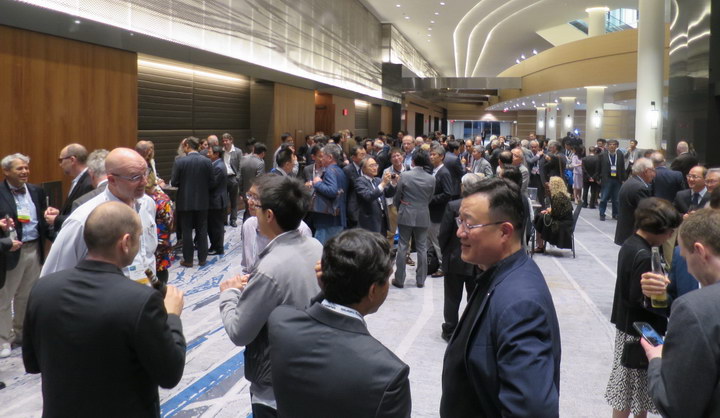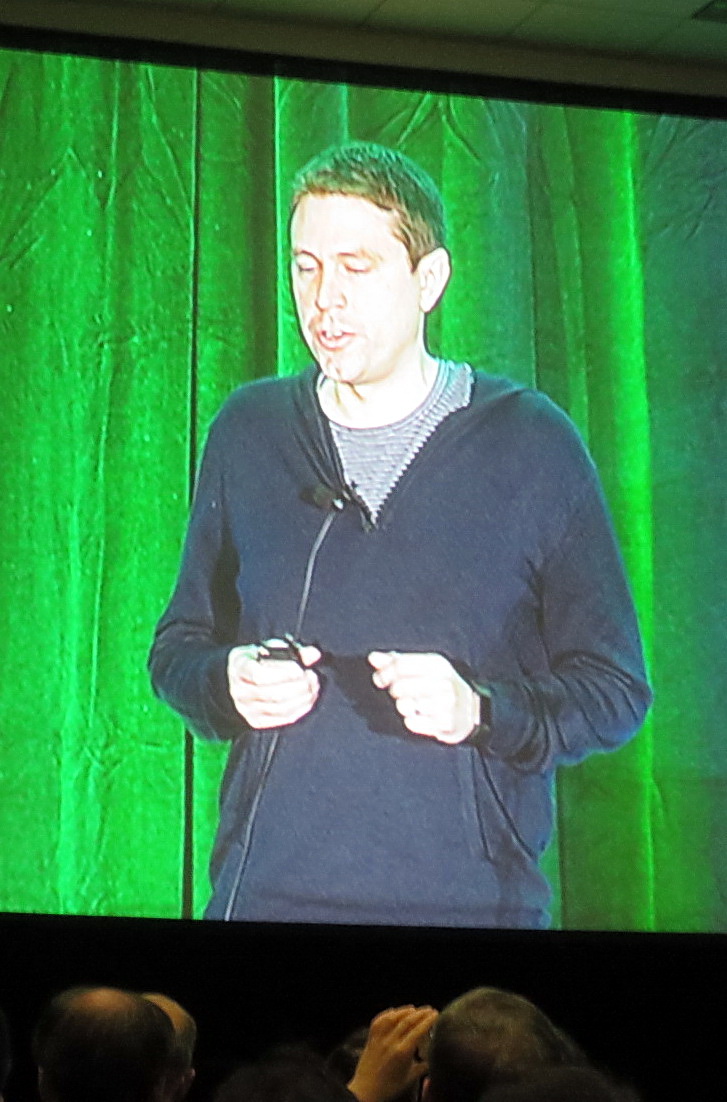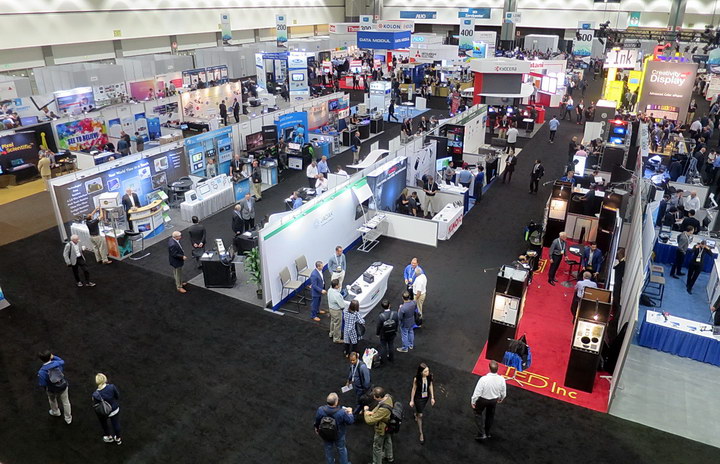VR Week in Los Angeles (more commonly called Display Week) is over and all the Meko people who attended are busy writing up their coverage of the event for the upcoming Display Week special report. My assignment was to cover Virtual and Augmented Reality and there was more than enough there for one person to cover.

 The President’s Reception at the Intercontinental Hotel on Monday of Display Week. (Credit: M. Brennesholtz)
The President’s Reception at the Intercontinental Hotel on Monday of Display Week. (Credit: M. Brennesholtz)
There were 12 time slots for technical sessions, three on Tuesday and Wednesday, four on Thursday and two on Friday. Not coincidentally, there were also 12 sessions on AR and VR, one in each time slot, which didn’t leave much time left over for other things. The 12 AR/VR sessions had a total of 59 technical paper and were:
- Session 3: AR/VR I: Display Systems. I presented invited paper 3.1 at this session titled “VR Standards and Guidelines.” Much of this paper was based on the four Display Daily articles I have written on VR standards an guidelines over the past year. I was pleased when over 500 conference attendees showed up to hear my talk. There were five papers in total in this session.
- Session 10: AR/VR II: Light-Field HMDs (four papers)
- Session 17: AR/VR III: Waveguide Optics (five papers)
- Session 23: AR/VR IV: Display Electronics (four Papers)
- Session 30: Input Technologies for AR/VR (four papers)
- Session 40: OLED AR/VR. Officially this was on the OLED track not the AR/VR track but, obviously, it is important to the AR/VR community. (Five papers)
- Session 44: Fast-Switching LCDs for AR/VR I (four papers)
- Session 51: Fast-Switching LCDs for AR/VR II (five papers)
- Session 58: High-Resolution LCDs for AR/VR (four papers)
- Session 65: Human Factors in AR/VR System (five papers) In many ways, I consider the most important AR/VR session. I don’t believe VR can ever become a mainstream product category unless it overcomes its major human factors problems, including VR sickness.
- Session 72: Measurement Challenges for Near-to-Eye Displays (four papers) Several of these papers also addressed measurement of human factors such as response time, latency and HMD brightness that are known to affect VR sickness. If there is a problem and you can’t measure it, it is very hard to fix it.
- Session 79: Enhancements to AR/VR (five papers) Since this was a five paper session, it lasted till 12:20 on Friday, after the nominal Noon ending of the Display Week technical sessions. The official end of Display Week was after the Friday Author Interviews, which ended at 1:00 in the afternoon.
 Meko’s Matt Brennesholtz tries a near-eye light field display from National Chiao-Tung University and Coretronic in the iZone. This system was discussed in papers 3.3 and P-94 of the symposium. (Credit: M. Brennesholtz)
Meko’s Matt Brennesholtz tries a near-eye light field display from National Chiao-Tung University and Coretronic in the iZone. This system was discussed in papers 3.3 and P-94 of the symposium. (Credit: M. Brennesholtz)
In addition to the 59 papers in the 12 oral technical sessions, there were an additional nine poster papers in the AR/VR portion of the Poster Paper session, which had a total of 214 papers. Both the oral and poster sessions had additional AR/VR technology papers scattered throughout the sessions.
There were multiple other sessions I would have liked to go to but had conflicts with the AR/VR sessions Bob wanted me to report on. These included:
- Session 37: Artificial Intelligence and Machine Learning. This was included on the AR/VR track, even though it conflicted with Session 40. Three of the four papers involved the use of AI in AR/VR applications. The fourth paper was a review of AI technology for multiple applications and was presented by Kailas Vodrahalli, University of California at Berkeley.
- Session 46: Ultra-High Resolution I (four papers)
- Session 53: Ultra-High Resolution II (three papers) While only one paper of the seven in sessions 46 & 53 dealt with a high resolution microdisplay suited for AR/VR applications, I feel the need of higher resolution in AR/VR HMDs would have justified attending that paper if there hadn’t been a conflict.
- Session 63: Projection: Image Improvement (four papers)
- Session 70: Projection: Screen Technology (four papers) I would have liked to have attended these two projection sessions since my background is in projection technology. AR/VR at Display week took precedence because it is a much more current and forward-looking technology. These eight papers represent, in many ways, the tail end of projection technology at SID. Projection used to have multiple sessions and it’s own paper selection sub-committee. Now it has been folded into Display Systems, the sub-committee that also includes AR and VR technology.
- Session 78: Color Gamut (four papers) there was no dedicated session for high dynamic range (HDR) at SID and the papers on HDR were scattered through multiple sessions. The question of color and HDR haven’t been a large part of AR or VR to date. Right now, the companies are trying to make it work – later, perhaps they can focus on these image quality issues.
 Douglas Lanman from Oculus delivered a keynote speech on eye-tracking in AR/VR systems. (Credit: M. Brennesholtz)
Douglas Lanman from Oculus delivered a keynote speech on eye-tracking in AR/VR systems. (Credit: M. Brennesholtz)
Display Week isn’t just technical sessions, there were other things important to the AR/VR community as well. One of the three keynote speakers, Douglas Lanman, Director of Computational Imaging at Oculus Research, spoke on “Reactive Displays: Unlocking Next-Generation VR/AR Visuals with Eye Tracking.”
There was an all-day conference on Wednesday titled “Market Focus Conference on Immersive Experience.” This conference had five sessions of it’s own. In general, the talks at the market focus conference focused on the market and applications of immersive systems rather than the details of the technologies. All types of immersive experiences were discussed, including both head-mounted display (HMD) based systems and direct view, multi-viewer systems such as CAVEs and dome projection.
 About one-third of the Display Week exhibition show floor, as seen from the press room. (Credit: M. Brennesholtz)
About one-third of the Display Week exhibition show floor, as seen from the press room. (Credit: M. Brennesholtz)
AR/VR companies also had a significant place in the exhibition at SID. While I spent most of my Display Week time in the technical sessions and the market focus conference, I found time to visit several exhibitors with specific AR/VR offerings. While I did a very brief scan of the show floor looking for additional AR/VR technology on display, I didn’t have time to truly appreciate the range of display technology and products in the exhibition. Others at Meko will be focusing on the exhibition in the SID special report. (we’ll also be at AWE Expo in Santa Clara next week – Man. Ed.)
Company business plans, marketing strategies, products, technologies and much more will be discussed in detail in the Meko special report on SID (subscription required), scheduled to come out the week of June 4th. It won’t just be AR & VR – it will cover all display technologies shown at Display Week. –Matthew Brennesholtz

